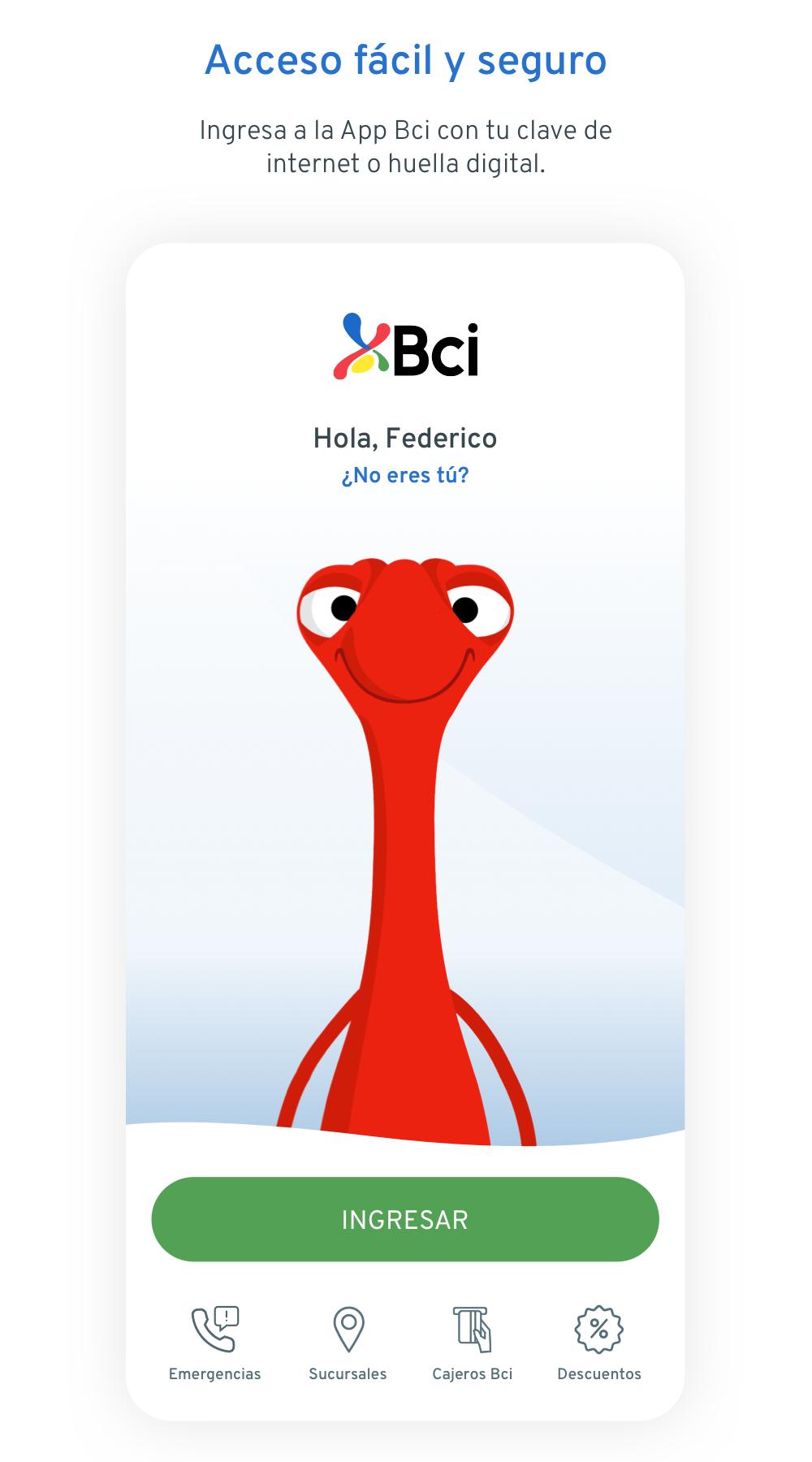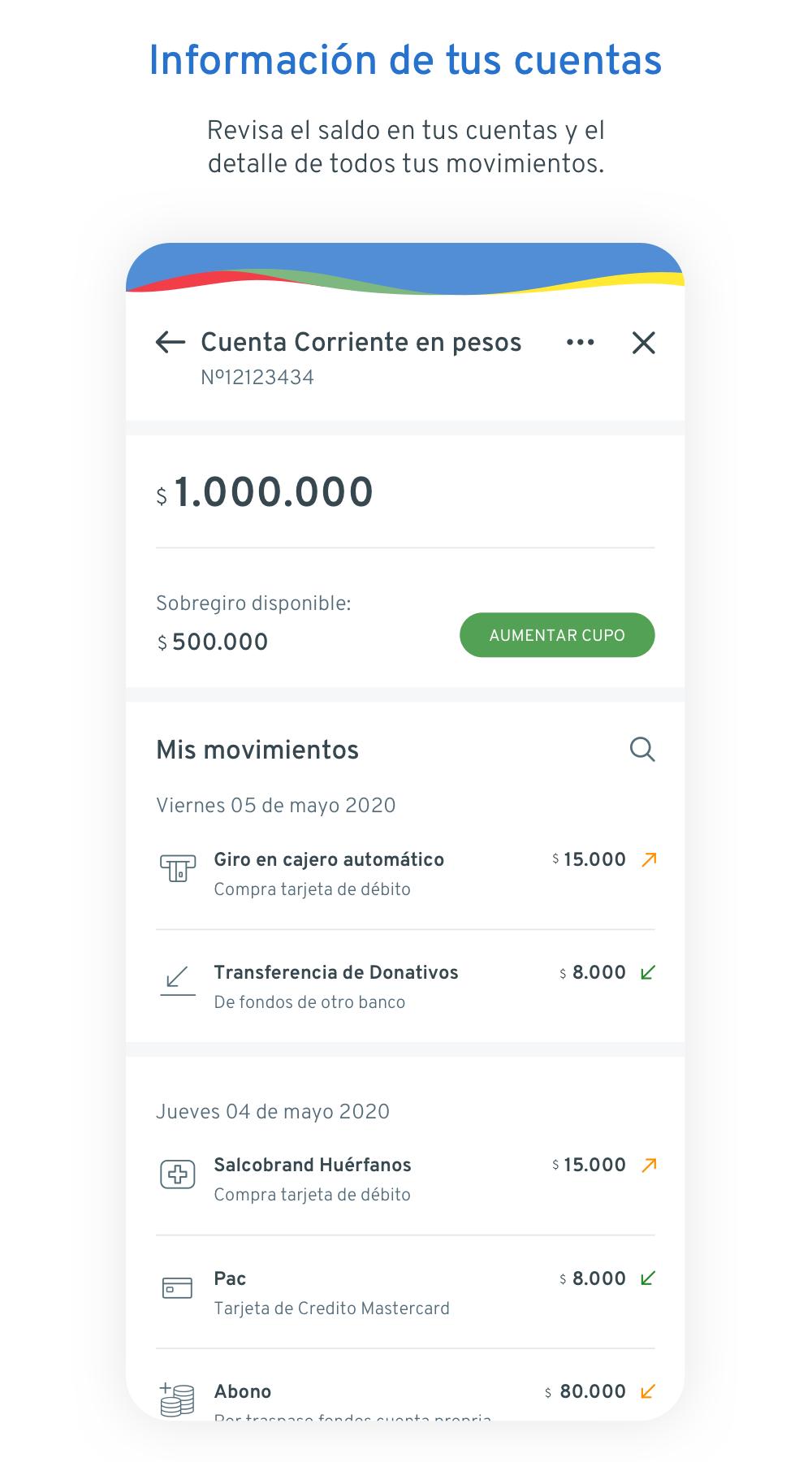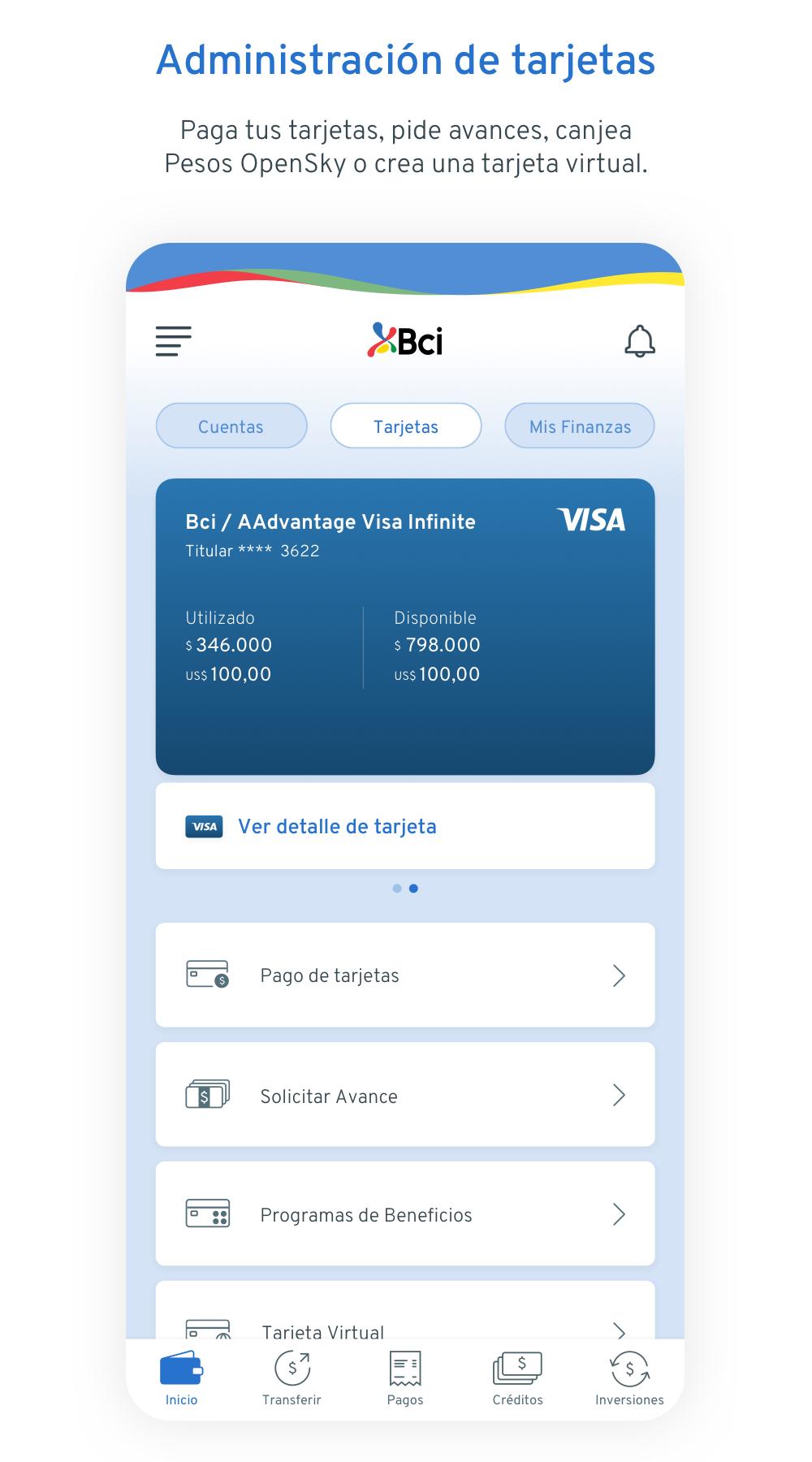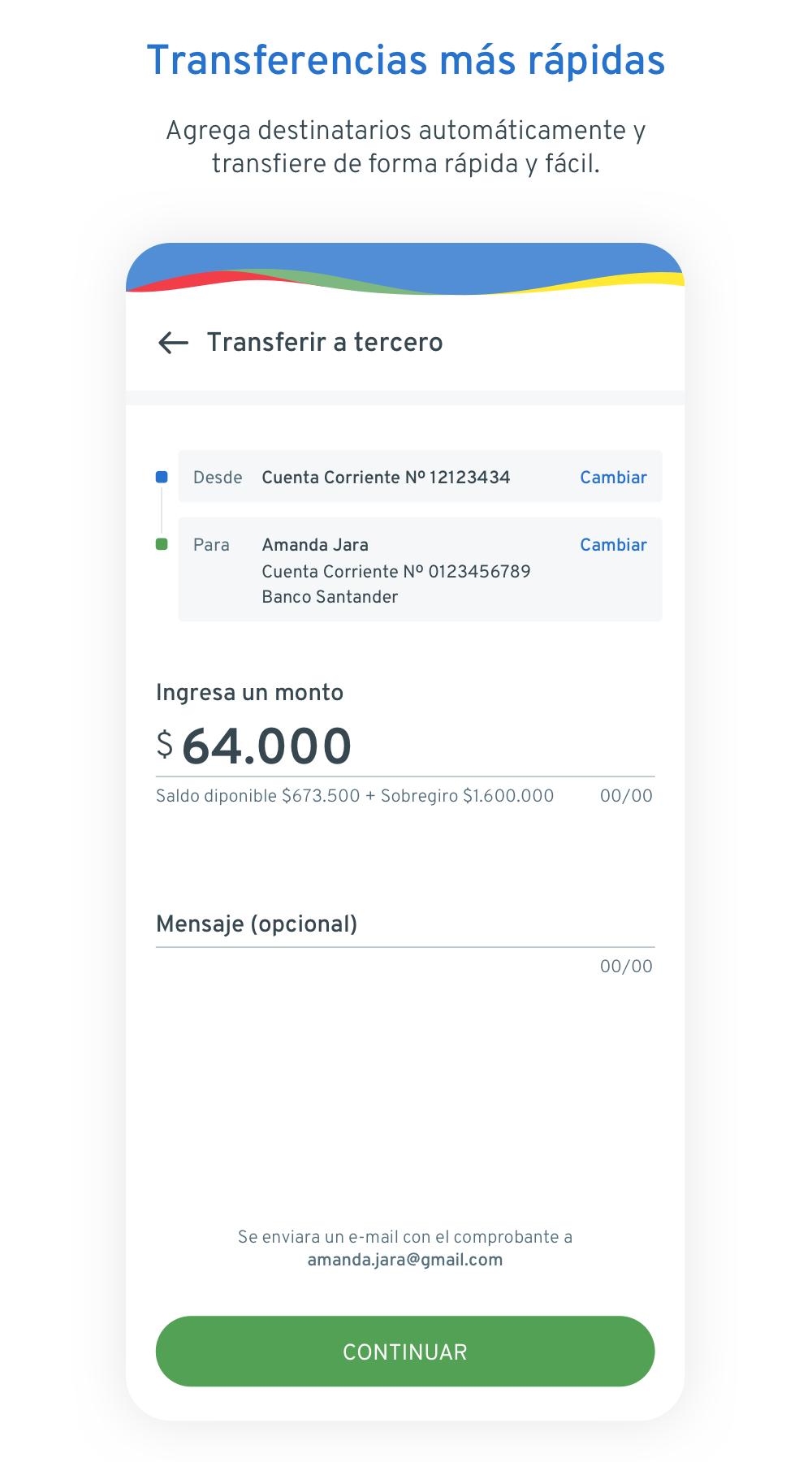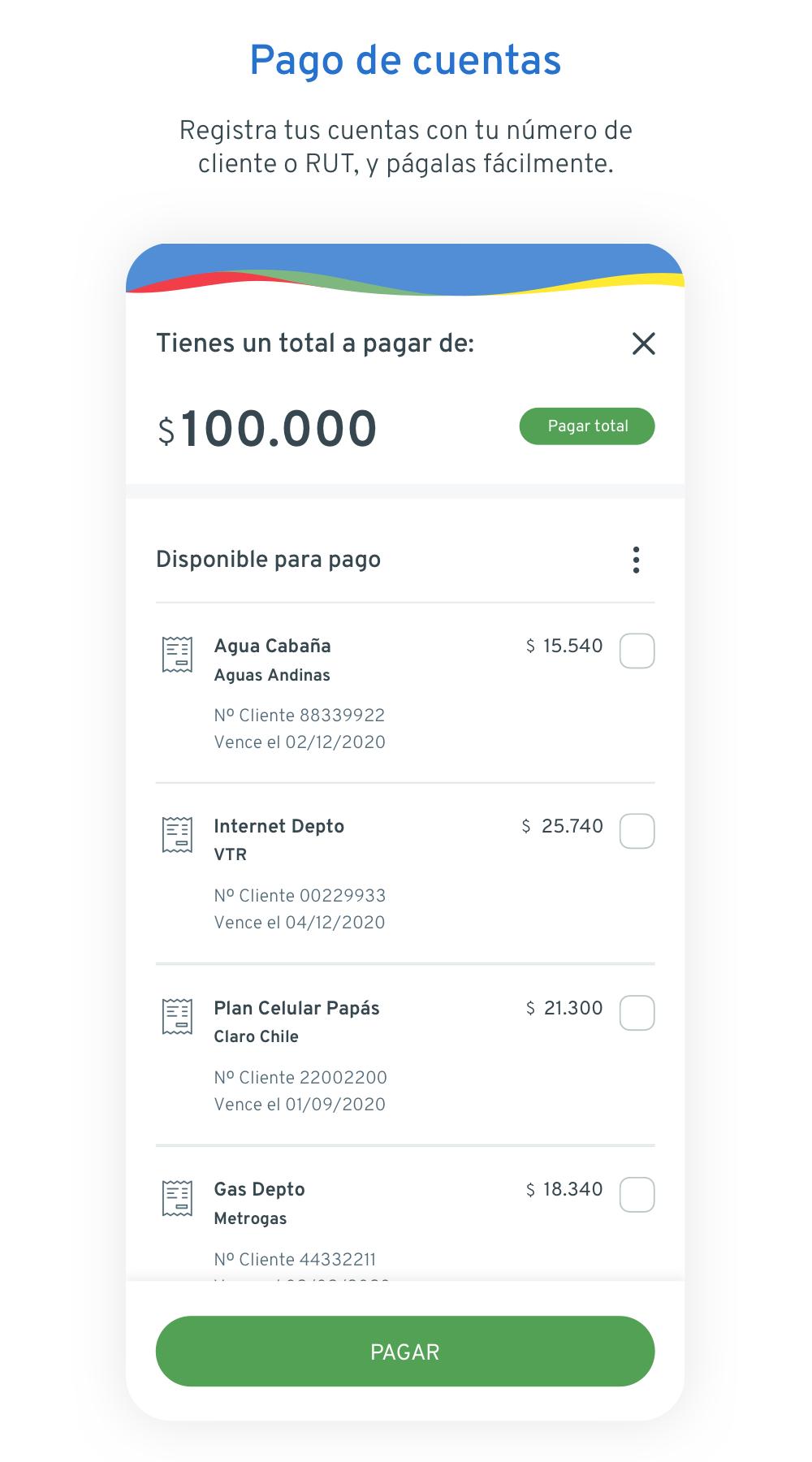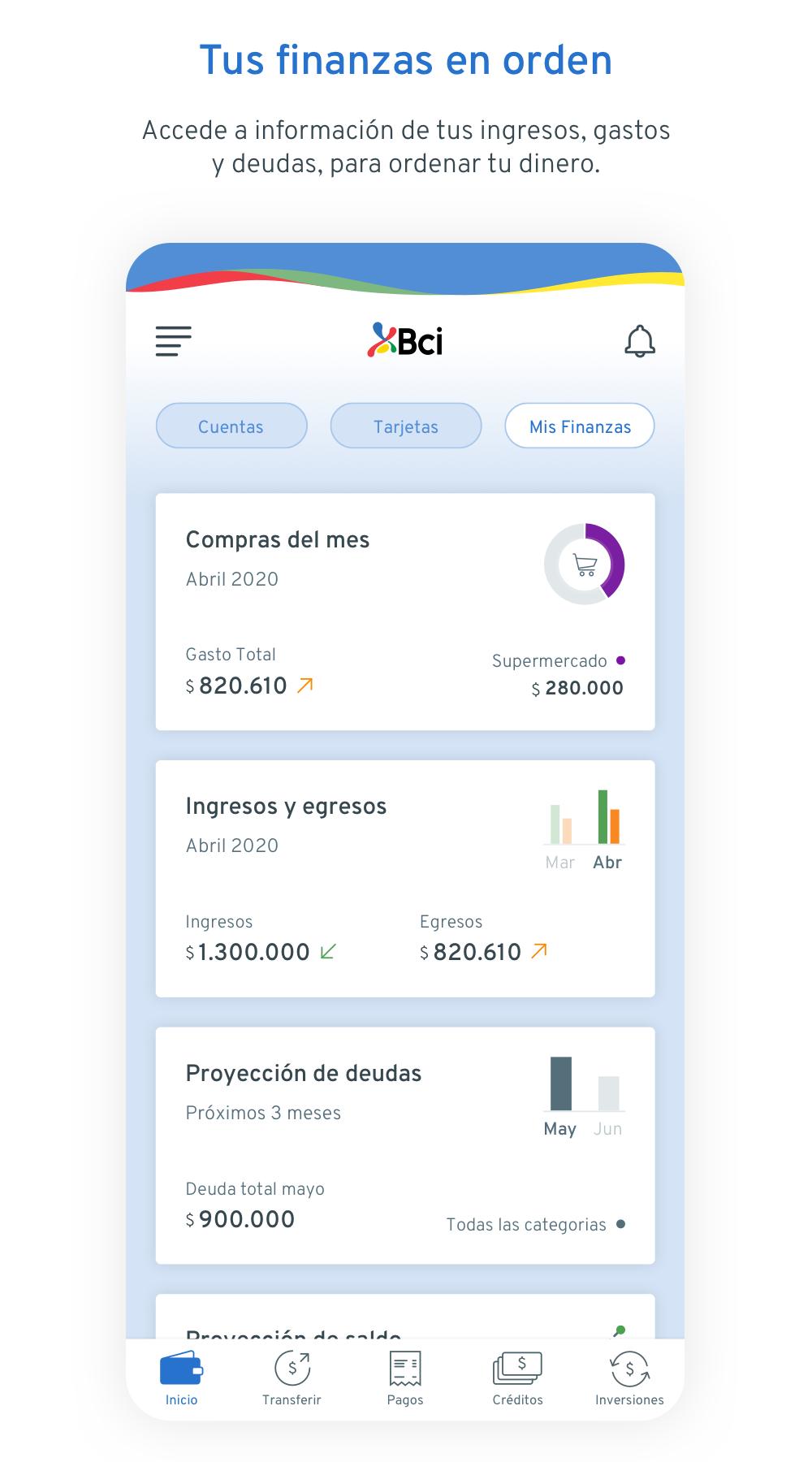Nueva App
¡La App Bci ahora es más fácil de usar! También tiene más funcionalidades que necesitas a diario y que harán tu vida más simple:
Al descargar la versión más reciente de la App Bci podrás:
● Ingresar con huella digital de forma rápida y segura.
● Agregar y cargar celulares, además de tu tarjeta bip!
● Transferir a destinatarios frecuentes o registrados.
● Agregar con un tap los datos de un destinatario que te envíen al celular.
● Agregar y pagar tus cuentas registradas y no registradas.
● Simular y contratar 100% online Fondos Mutuos y Depósitos a Plazo.
● Revisar todos los movimientos de tu cuenta corriente o cuenta prima.
● Pagar tu crédito de consumo y línea de sobregiro.
● Hacer avances desde tu tarjeta de crédito a tu cuenta corriente.
● Ver los movimientos facturados y no facturados de tu tarjeta de crédito.
● Pagar tu tarjeta de crédito nacional e internacional.
● Bloquear temporalmente y desbloquear tu tarjeta de crédito.
● Dar aviso de un próximo uso de tu tarjeta de crédito en el extranjero.
● Aumentar el cupo de tu tarjeta de crédito nacional o internacional.
● Revisar el estado de cuenta de tu tarjeta de crédito.
● Si así lo configuraste en Bci.cl, podrás recibir notificaciones de compras con tarjetas de crédito y débito.
● Solicitar el canje de los Pesos OpenSky que tú quieras, directamente en la App.
● Generar una tarjeta virtual.
● Acceder a Mis Finanzas, un nuevo servicio que clasifica tus gastos en rubros.
● En Mis Finanzas verás fácilmente el flujo mensual de tus ingresos y egresos.
● Ver ofertas personalizadas según tus intereses y necesidades.
● Acceder a descuentos directamente en la sección Vivir con Beneficios.
¡Seguimos trabajando para mejorar cada día más tu experiencia y ofrecerte más servicios en las próximas versiones de la App Bci!
Infórmate sobre la garantía estatal de los depósitos en tu banco o en la Comisión para el Mercado Financiero (CMF), en www.cmfchile.cl.
What's New in the Latest Version 10.16.1
Last updated on Jun 28, 2024
En esta nueva versión hicimos algunas correcciones para que sea más rápido cargar y usar tu App Bci.
Brain-Computer Interfaces (BCIs), sometimes referred to as Neural-Control Interfaces (NCIs), represent a groundbreaking field bridging the gap between the human brain and external devices. These systems establish a direct communication pathway, allowing individuals to interact with computers or machines solely through neural activity, bypassing traditional methods like keyboards or mice. BCIs hold immense potential for a wide range of applications, from assistive technologies for individuals with disabilities to enhancing human capabilities and exploring new forms of human-computer interaction.
BCIs function by detecting and interpreting specific patterns of brain activity. Electroencephalography (EEG), a non-invasive technique that measures electrical activity on the scalp, is a commonly employed method for acquiring brain signals. Other methods include electrocorticography (ECoG), which involves placing electrodes directly on the surface of the brain, and intracortical recordings, which utilize implanted microelectrodes to detect the activity of individual neurons. Each method offers different trade-offs in terms of signal quality, invasiveness, and complexity.
Once brain signals are acquired, they are processed and translated into commands that can control external devices. This process involves sophisticated signal processing algorithms that filter out noise and extract relevant features from the complex brain activity. Machine learning techniques, such as pattern recognition and classification, are often employed to identify specific brain patterns associated with different intentions or commands.
One of the most promising applications of BCIs is in the realm of assistive technologies. Individuals with severe motor impairments, such as paralysis or locked-in syndrome, can utilize BCIs to regain control over their environment. BCI-controlled prosthetics, wheelchairs, and communication devices can provide a newfound sense of independence and improve quality of life. For example, BCIs can enable individuals to type messages, control a robotic arm, or navigate a power wheelchair using only their thoughts.
Beyond assistive applications, BCIs are also being explored for enhancing human capabilities. Researchers are investigating the potential of BCIs to improve cognitive functions, such as memory and attention. BCIs could also be used to create novel interfaces for interacting with virtual reality environments or controlling complex machinery. In the future, BCIs might even enable direct brain-to-brain communication, opening up entirely new possibilities for human interaction.
However, the development and implementation of BCIs face several challenges. The complexity and variability of brain signals make it difficult to develop robust and reliable decoding algorithms. The invasiveness of some BCI methods raises ethical concerns and limits their widespread adoption. Furthermore, the cost and complexity of BCI systems can be prohibitive for many individuals.
Despite these challenges, the field of BCIs is rapidly advancing. Ongoing research is focused on improving the accuracy and reliability of BCI systems, developing less invasive recording techniques, and exploring new applications. As technology continues to evolve, BCIs are poised to revolutionize the way we interact with computers and the world around us, offering unprecedented opportunities for individuals with disabilities and potentially transforming human capabilities in the years to come. From restoring lost function to augmenting existing abilities, BCIs hold the promise of a future where the power of the human mind can be harnessed in ways previously unimaginable.
The development of BCIs is a multidisciplinary endeavor, involving neuroscientists, engineers, computer scientists, and clinicians. Collaboration and open sharing of data and knowledge are crucial for accelerating progress in this field. As the technology matures and becomes more accessible, BCIs have the potential to transform lives and reshape the future of human-computer interaction. The journey from laboratory curiosity to real-world application is ongoing, but the potential benefits are immense, driving continued innovation and exploration in this exciting field. The future of BCIs is bright, with the potential to unlock new frontiers in human potential and create a more inclusive and empowering future for all.
Nueva App
¡La App Bci ahora es más fácil de usar! También tiene más funcionalidades que necesitas a diario y que harán tu vida más simple:
Al descargar la versión más reciente de la App Bci podrás:
● Ingresar con huella digital de forma rápida y segura.
● Agregar y cargar celulares, además de tu tarjeta bip!
● Transferir a destinatarios frecuentes o registrados.
● Agregar con un tap los datos de un destinatario que te envíen al celular.
● Agregar y pagar tus cuentas registradas y no registradas.
● Simular y contratar 100% online Fondos Mutuos y Depósitos a Plazo.
● Revisar todos los movimientos de tu cuenta corriente o cuenta prima.
● Pagar tu crédito de consumo y línea de sobregiro.
● Hacer avances desde tu tarjeta de crédito a tu cuenta corriente.
● Ver los movimientos facturados y no facturados de tu tarjeta de crédito.
● Pagar tu tarjeta de crédito nacional e internacional.
● Bloquear temporalmente y desbloquear tu tarjeta de crédito.
● Dar aviso de un próximo uso de tu tarjeta de crédito en el extranjero.
● Aumentar el cupo de tu tarjeta de crédito nacional o internacional.
● Revisar el estado de cuenta de tu tarjeta de crédito.
● Si así lo configuraste en Bci.cl, podrás recibir notificaciones de compras con tarjetas de crédito y débito.
● Solicitar el canje de los Pesos OpenSky que tú quieras, directamente en la App.
● Generar una tarjeta virtual.
● Acceder a Mis Finanzas, un nuevo servicio que clasifica tus gastos en rubros.
● En Mis Finanzas verás fácilmente el flujo mensual de tus ingresos y egresos.
● Ver ofertas personalizadas según tus intereses y necesidades.
● Acceder a descuentos directamente en la sección Vivir con Beneficios.
¡Seguimos trabajando para mejorar cada día más tu experiencia y ofrecerte más servicios en las próximas versiones de la App Bci!
Infórmate sobre la garantía estatal de los depósitos en tu banco o en la Comisión para el Mercado Financiero (CMF), en www.cmfchile.cl.
What's New in the Latest Version 10.16.1
Last updated on Jun 28, 2024
En esta nueva versión hicimos algunas correcciones para que sea más rápido cargar y usar tu App Bci.
Brain-Computer Interfaces (BCIs), sometimes referred to as Neural-Control Interfaces (NCIs), represent a groundbreaking field bridging the gap between the human brain and external devices. These systems establish a direct communication pathway, allowing individuals to interact with computers or machines solely through neural activity, bypassing traditional methods like keyboards or mice. BCIs hold immense potential for a wide range of applications, from assistive technologies for individuals with disabilities to enhancing human capabilities and exploring new forms of human-computer interaction.
BCIs function by detecting and interpreting specific patterns of brain activity. Electroencephalography (EEG), a non-invasive technique that measures electrical activity on the scalp, is a commonly employed method for acquiring brain signals. Other methods include electrocorticography (ECoG), which involves placing electrodes directly on the surface of the brain, and intracortical recordings, which utilize implanted microelectrodes to detect the activity of individual neurons. Each method offers different trade-offs in terms of signal quality, invasiveness, and complexity.
Once brain signals are acquired, they are processed and translated into commands that can control external devices. This process involves sophisticated signal processing algorithms that filter out noise and extract relevant features from the complex brain activity. Machine learning techniques, such as pattern recognition and classification, are often employed to identify specific brain patterns associated with different intentions or commands.
One of the most promising applications of BCIs is in the realm of assistive technologies. Individuals with severe motor impairments, such as paralysis or locked-in syndrome, can utilize BCIs to regain control over their environment. BCI-controlled prosthetics, wheelchairs, and communication devices can provide a newfound sense of independence and improve quality of life. For example, BCIs can enable individuals to type messages, control a robotic arm, or navigate a power wheelchair using only their thoughts.
Beyond assistive applications, BCIs are also being explored for enhancing human capabilities. Researchers are investigating the potential of BCIs to improve cognitive functions, such as memory and attention. BCIs could also be used to create novel interfaces for interacting with virtual reality environments or controlling complex machinery. In the future, BCIs might even enable direct brain-to-brain communication, opening up entirely new possibilities for human interaction.
However, the development and implementation of BCIs face several challenges. The complexity and variability of brain signals make it difficult to develop robust and reliable decoding algorithms. The invasiveness of some BCI methods raises ethical concerns and limits their widespread adoption. Furthermore, the cost and complexity of BCI systems can be prohibitive for many individuals.
Despite these challenges, the field of BCIs is rapidly advancing. Ongoing research is focused on improving the accuracy and reliability of BCI systems, developing less invasive recording techniques, and exploring new applications. As technology continues to evolve, BCIs are poised to revolutionize the way we interact with computers and the world around us, offering unprecedented opportunities for individuals with disabilities and potentially transforming human capabilities in the years to come. From restoring lost function to augmenting existing abilities, BCIs hold the promise of a future where the power of the human mind can be harnessed in ways previously unimaginable.
The development of BCIs is a multidisciplinary endeavor, involving neuroscientists, engineers, computer scientists, and clinicians. Collaboration and open sharing of data and knowledge are crucial for accelerating progress in this field. As the technology matures and becomes more accessible, BCIs have the potential to transform lives and reshape the future of human-computer interaction. The journey from laboratory curiosity to real-world application is ongoing, but the potential benefits are immense, driving continued innovation and exploration in this exciting field. The future of BCIs is bright, with the potential to unlock new frontiers in human potential and create a more inclusive and empowering future for all.



